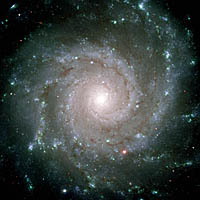The lifecycle of stars – Orion
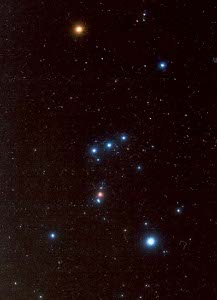 When looking at Orion, below the well-known
When looking at Orion, below the well-known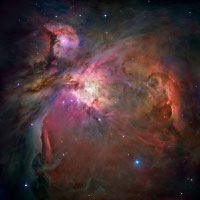 belt can be found the fainter stars
of the sword, the middle one of which has a hazy or smudged appearance to
the naked eye. Rather than a star, this is actually a star-forming region
known as the Orion Nebula. Nebulae are vast clouds of gas and dust, within
which gravity is causing material to clump together to the point where the
objects formed are subjected to sufficient pressure and temperature rise
that nuclear fusion can begin. However the appearance of a very young star
is considerably different than that of an older star, both in terms of colour
and how clearly it can be seen.
belt can be found the fainter stars
of the sword, the middle one of which has a hazy or smudged appearance to
the naked eye. Rather than a star, this is actually a star-forming region
known as the Orion Nebula. Nebulae are vast clouds of gas and dust, within
which gravity is causing material to clump together to the point where the
objects formed are subjected to sufficient pressure and temperature rise
that nuclear fusion can begin. However the appearance of a very young star
is considerably different than that of an older star, both in terms of colour
and how clearly it can be seen.
Unlike the water taps in your home, a hotter star is bluish in colour, while cooler stars take on first a yellow, then reddish tint. The same is true of flames, where the hottest part of the flame is the blue part, or of metal, where a white piece of metal is considerably hotter than a chunk glowing a dull red. Observing the left shoulder of Orion, a giant star called Betelguese, and comparing it with his right foot, Rigel, the difference is clear to see. This is due to the gasses which make up the star at different stages. When first formed, the young star is composed almost entirely of hydrogen, which is fused together to form atoms of helium, releasing heat and light in the process. Eventually though, all the hydrogen is consumed, and helium becomes the fuel to keep the fusion reaction going, until the helium in turn is consumed, and progressively heavier elements are formed as core temperature increases. Overall energy release consistently drops as the elements become larger however, so the star cools, and progresses from blue-white, to white, to yellow, orange and then red in a typical example.
So, stars do not stay the same for ever. In the Orion nebula the process
is just beginning, however observation of the neighbouring constellation
of Taurus allows us to see a later stage, of ‘teenage’ stars, about 65 million
years old. The cluster of stars known as the 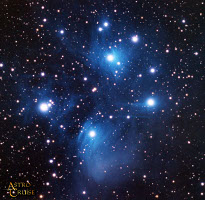 Pleiades or Seven Sisters have
moved on compared to the Orion Nebula, and have blown away most of the surrounding
cloud of gas and dust to be revealed as blue-white young stars. Moving on
in age, we come back to Rigel, a very luminous white star, and further on,
returning to Betelguese the red super-giant. The final stage of a star’s
life depends on its mass – massive stars tend to end in a spectacular collapse
and explosion called a supernova. This will
Pleiades or Seven Sisters have
moved on compared to the Orion Nebula, and have blown away most of the surrounding
cloud of gas and dust to be revealed as blue-white young stars. Moving on
in age, we come back to Rigel, a very luminous white star, and further on,
returning to Betelguese the red super-giant. The final stage of a star’s
life depends on its mass – massive stars tend to end in a spectacular collapse
and explosion called a supernova. This will 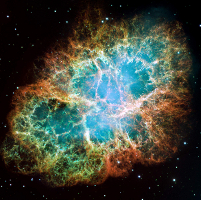 happen to Betelguese in millions
of years time. Stars like our sun live more sedate lives – the sun is about
halfway through its roughly 9 billion year lifespan, and as it nears the
end of its life, it will expand to swallow up the inner planets, including
Earth, before the pressure of the radiating energy from within can no longer support the outer layers against gravity,
and the star will shrink again, to gradually dwindle and fade. Interestingly,
since the normal nuclear fusion in even a massive star stops once the elements
combine to make iron, all heavier elements can only be made in the catastrophic
release of energy in supernovae, and the elements that make up you, your
computer and house all originated in a star, or were produced when a star
died. You really are made of stardust!
happen to Betelguese in millions
of years time. Stars like our sun live more sedate lives – the sun is about
halfway through its roughly 9 billion year lifespan, and as it nears the
end of its life, it will expand to swallow up the inner planets, including
Earth, before the pressure of the radiating energy from within can no longer support the outer layers against gravity,
and the star will shrink again, to gradually dwindle and fade. Interestingly,
since the normal nuclear fusion in even a massive star stops once the elements
combine to make iron, all heavier elements can only be made in the catastrophic
release of energy in supernovae, and the elements that make up you, your
computer and house all originated in a star, or were produced when a star
died. You really are made of stardust!
